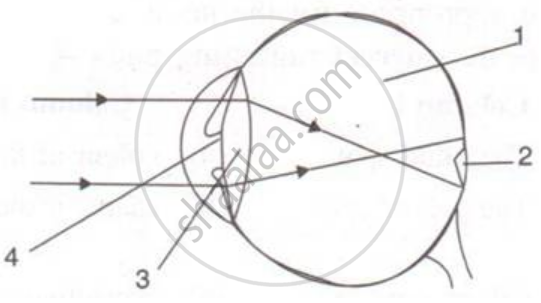Advertisements
Advertisements
प्रश्न
What are the two most common defects of vision (or defects of eye)? How are they corrected?
उत्तर
The two most common defects of vision (or defects of the eye) are the following.
1. Myopia (short-sightedness or near-sightedness): Myopia is an eye defect because of which a person cannot see faraway objects clearly but can see nearby objects normally. By using spectacles with concave lenses, myopia can be corrected, as a concave lens reduces the converging power of the eye lens and therefore forms the images of faraway objects on the retina of the myopic eye.
2. Hypermetropia (long-sightedness or far-sightedness): Hypermetropia is an eye defect because of which a person cannot see nearby objects clearly but can see faraway objects normally. By using spectacles with convex lenses, hypermetropia can be corrected, as a convex lens increases the converging power of the eye lens and therefore forms the images of nearby objects on the retina of the hypermetropic eye.
The two most common defects of vision (or defects of the eye) are the following.
1. Myopia (short-sightedness or near-sightedness): Myopia is an eye defect because of which a person cannot see faraway objects clearly but can see nearby objects normally. By using spectacles with concave lenses, myopia can be corrected, as a concave lens reduces the converging power of the eye lens and therefore forms the images of faraway objects on the retina of the myopic eye.
2. Hypermetropia (long-sightedness or far-sightedness): Hypermetropia is an eye defect because of which a person cannot see nearby objects clearly but can see faraway objects normally. By using spectacles with convex lenses, hypermetropia can be corrected, as a convex lens increases the converging power of the eye lens and therefore forms the images of nearby objects on the retina of the hypermetropic eye.
The two most common defects of vision (or defects of the eye) are the following.
1. Myopia (short-sightedness or near-sightedness): Myopia is an eye defect because of which a person cannot see faraway objects clearly but can see nearby objects normally. By using spectacles with concave lenses, myopia can be corrected, as a concave lens reduces the converging power of the eye lens and therefore forms the images of faraway objects on the retina of the myopic eye.
2. Hypermetropia (long-sightedness or far-sightedness): Hypermetropia is an eye defect because of which a person cannot see nearby objects clearly but can see faraway objects normally. By using spectacles with convex lenses, hypermetropia can be corrected, as a convex lens increases the converging power of the eye lens and therefore forms the images of nearby objects on the retina of the hypermetropic eye.v
APPEARS IN
संबंधित प्रश्न
The far point of a myopic person is 80 cm in front of the eye. What is the nature and power of the lens required to correct the problem?
What is the far point of a person suffering from myopia (or short-sightedness)?
Explain with the help of labelled ray-diagram, the defect of vision called hypermetropia, and hot it is corrected by a lens.
What is long-sightedness? State the two causes of long-sightedness (or hypermetropia). With the help of ray diagrams, show:
(i) the eye-defect long-sightedness.
(ii) correction of long-sightedness by using a lens.
The defect of vision which cannot be corrected by using spectacles is:
(a) myopia
(b) presbyopia
(c) cataract
(d) hypermetropia
Describe the mechanism of focusing the image of a distant object in your eye when you raise your head after reading a book.
Choose the correct answer :
Presbyopia is a disease of _____________
Given below is a diagram depicting a defect of the human eye? Study the same and answer the question that follow:

Give two possible reasons for this defect of the eye in human beings.
Complete the following sentence with appropriate word :
An inability to focus on nearby objects due to loss of elasticity of the lens with age is called Iris.
Differentiate the eye defects: Myopia and Hypermetropia
